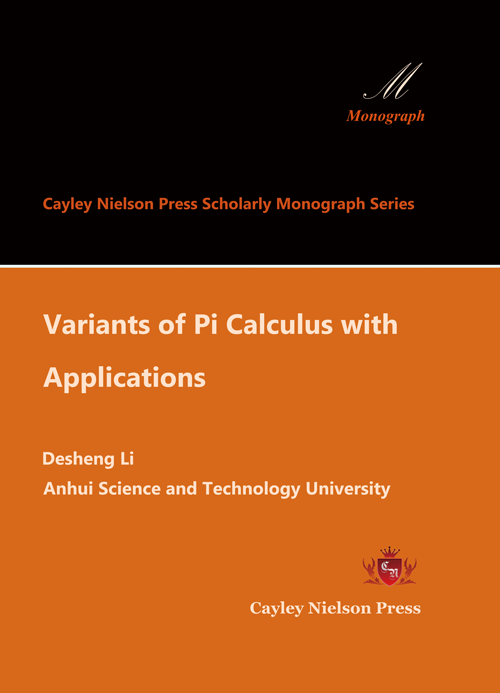
Variants of Pi Calculus with Applications

Desheng Li
Anhui Science and Technology University
Copyright © 2018 by Cayley Nielson Press, Inc.
ISBN: 978-1-5323-9658-8
Cayley Nielson Press Scholarly Monograph Series Book Code No.: 201-2-6
US$152.50
Preface
Based on the previous research, this Monograph uses Pi calculus and its extension as a formal tool to discuss the main issues in the service life cycle including service modeling, selection, combination, and verification. The specific contents include the following:
(1) Study the definitions, categories, methodologies and technologies of formalization of Web services at home and abroad, and clarify the research direction of service composition.
(2) Study the relevant theories and techniques of the formal method Pi calculus at home and abroad, and master the grammatical semantics and typed techniques of Pi calculus.
(3) Type extension of traditional Pi calculus for the characteristics of service composition: grammar extension has constrained channel, logical parallel and logical selection; semantic extension has beam channel link semantic rule, logical parallel and logical selection transformation rule.
(4) As a structured formal modeling language, although all Pi calculus versions can easily represent the operational semantics of concurrent processes, they are not as intuitive as Petri nets. Therefore, in order to accommodate the new primitives that extend the Pi calculus, we design a graphical representation notation APG to explicitly assign concurrency and logical relationships. Although it is not possible to fully represent the semantics of Pi calculus, it is helpful to understand and analyze Pi calculus and modeling Web services.
(5) Based on the extended Pi-beam calculus, a detailed rationality discussion of the type system is given, and a strict proof is given.
(6) Based on the extended Pi-beam calculus, the atomic services and composite services of Web services are modeled, and the related combination paradigm is proposed. Based on the paradigm, two rationalities of type rationality and process rationality are proposed, and the definition and determination methods of deadlock, deadlock freedom, livelock and livelock freedom are realized. In addition, based on the correctness guarantee, an automatic service combination algorithm using heuristic reasoning technology is proposed. It is used to automate combinatorial algorithms with polynomial time complexity.
(7) An extended cost Pi calculus is proposed, which can transform the search process of evolutionary algorithms such as PSO into its built-in primitives. Then a detailed scheme is proposed for the design pattern of discretized PSO. Based on the language, a PSO-based QoS-aware Web service selection method based on abstract syntax tree is developed.
Desheng Li
Anhui Science and Technology University
Anhui, Bengbu & Chuzhou, China
September, 2018
Contents
Preface.......................................................................................................... I
1 Introduction.............................................................................................. 1
1.1 Process Algebra..................................................................................... 1
1.2 Pi Calculus............................................................................................. 5
2 Extended Pi Calculus: Pi-Beam............................................................. 15
2.1 Language............................................................................................. 15
2.1.1 Syntax............................................................................................... 15
2.1.1.1 Constrained Channel Bundle......................................................... 19
2.1.1.2 Logical Parallel Links and Logical Selection............................... 27
2.1.2 Semantics......................................................................................... 33
2.1.2.1 Structure Congruence.................................................................... 33
2.1.2.2 Reduction Semantics..................................................................... 37
2.1.2.3 Lts.................................................................................................. 37
2.1.3 Type System..................................................................................... 38
2.1.3.1 Type............................................................................................... 39
2.1.3.2 Typing........................................................................................... 39
2.1.3.3 Running Error................................................................................ 41
2.2 Soundness............................................................................................ 43
2.2.1 Soundness of Typing System........................................................... 43
2.2.2 Soundnesses of Beam Channel........................................................ 49
2.2.3 Balance Soundness of Process' Beam Channel................................ 50
2.3 Equivalence......................................................................................... 50
3 Graphical Representation of Pi-Beam.................................................... 55
3.1 Related Graphical Representation....................................................... 55
3.2 Label Connection Process Diagram.................................................... 58
3.3 Summary............................................................................................. 60
4 Pi Calculus Experimental Environment................................................. 62
4.1 Overall Structure................................................................................. 62
4.2 Pi Calculus Compilation Execution Environment.............................. 64
4.2.1 Package Structure Diagram.............................................................. 64
4.2.2 Compiler Front End.......................................................................... 66
4.2.3 Compiler Backend............................................................................ 70
4.3 Summary............................................................................................. 70
5 Pi-Beam-Cost Calculus.......................................................................... 72
5.1 Problem Description............................................................................ 72
5.1.1 Qos Of Service................................................................................. 72
5.1.2 Qos-Aware Service Composition Problem...................................... 75
5.1.3 Qos-Aware Service Composition Method....................................... 79
5.1.4 Formal Method of Intelligent System Based On Process Algebra.. 81
5.2 Language............................................................................................. 85
5.2.1 Syntax............................................................................................... 85
5.2.2 Semantics......................................................................................... 86
5.2.2.1 Structured Congruence.................................................................. 87
5.2.2.2 Lts.................................................................................................. 88
5.2.2.3 Cost Measure Operator.................................................................. 91
5.2.2.4 Cost Measurement of Equivalent Services................................... 95
5.2.2.5 Pso Meta-Control Process............................................................. 97
6 Modeling And Design of Qos-Aware Web Service Selection.............. 102
6.1 Scenes................................................................................................ 102
6.2 Pi-Beam-Cost for Qos-Aware Web Service Composition................ 104
6.2.1 Pso Optimization Process............................................................... 115
6.2.1 Dpso Design of Model.................................................................... 117
6.2.1.1 Dpso Introduction........................................................................ 117
6.2.1.2 Representation of The Solution................................................... 117
6.2.1.3 Physical Representation of Particles........................................... 120
6.2.1.4 Particle Dynamics Definition...................................................... 121
6.2.1.5 Fitness Function Design and Calculation.................................... 123
6.2.1.6 The Main Process of Dpso.......................................................... 125
6.3 Simulation......................................................................................... 129
6.3.1 Establishment of Simulation Platform........................................... 129
6.3.2 Experimental Result....................................................................... 131
6.4 Summary........................................................................................... 133
Appendix I: Symbol Table...................................................................... 135
References............................................................................................... 136
Readership
This book should be useful for students, scientists, engineers and professionals working in the areas of optoelectronic packaging, photonic devices, semiconductor technology, materials science, polymer science, electrical and electronics engineering. This book could be used for one semester course on adhesives for photonics packaging designed for both undergraduate and graduate engineering students.
